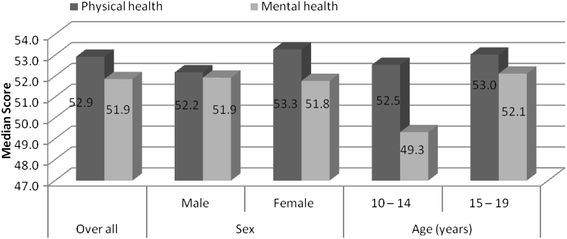Reproductive health and lifestyle factors associated with health-related quality of life among perinatally HIV-infected adolescents in Uganda
- PMID: 26490047
- PMCID: PMC4618375
- DOI: 10.1186/s12955-015-0366-6
Reproductive health and lifestyle factors associated with health-related quality of life among perinatally HIV-infected adolescents in Uganda
Abstract
Background: With increased survival of perinatally HIV - infected adolescents due to antiretroviral therapy (ART), the focus of HIV care has shifted to health-related quality of life (HRQoL) as a measure of disease progression, effects of ART co-morbidity and prognosis. We assessed factors associated with better HRQoL in perinatally HIV -infected adolescents in Uganda by determining the associations between sexual and reproductive health (SRH) or lifestyle experiences on HRQoL.
Methods: In a cross-sectional study, data on SRH, lifestyle experiences, socio demographic factors, communication with parents on sexuality and satisfaction of SRH services in ART clinics were collected from 614 HIV perinatally infected adolescents aged 10-19 using an interviewer-administered survey questionnaire. HRQoL data were collected using the Medical Outcomes Study HIV Health Survey instrument (MOS-HIV). Factors associated with better HRQoL were analysed using multiple logistic regression.
Results: The mean age was 16.2 ± 2.1 years, 362 (58.8 %) were females and 210 (34.2 %) were sexually active. Adolescents on ART were twice likely to present with better physical health (AOR = 2.07, 95 % CI: 1.24-3.46) and four times more likely to present with better mental health (AOR = 3.9, 95 % CI: 2.22-6.92) than those who were not on ART. There were no statistically significant associations between SRH (ever had sex, ever been pregnant, condom use, contraceptive use) or life style factors and physical health or mental health. Those with secondary or tertiary education were more likely to present with a better mental health (AOR = 5.3, 95 % CI: 1.86-15.41) compared those who had attained primary or no education. Participants who desired to have a child in future more likely (AOR 1.7, 95 % CI: 1.05-3.00) to present with a better mental health. Lack of communication with guardians on sexuality (AOR = 0.6, 95 % CI: 0.40-0.89), or dissatisfaction with SRH services (AOR 0.34, 95 % CI: 0.18-0.62) were associated with poorer mental health.
Conclusion: Among perinatally HIV-infected adolescents in Uganda, being on ART was associated with better physical and mental health while lack of communication with guardians on sexuality or dissatisfaction with SRH services was associated with poor mental health. Adolescents with pregnancy intentions were more likely to have a better mental health.
Figures
Similar articles
-
Correlates of ever had sex among perinatally HIV-infected adolescents in Uganda.Reprod Health. 2015 Oct 16;12:96. doi: 10.1186/s12978-015-0082-z. Reprod Health. 2015. PMID: 26475268 Free PMC article.
-
Knowledge and perceptions of sexual and reproductive health and HIV among perinatally HIV-infected adolescents in rural China.AIDS Care. 2015;27(9):1137-42. doi: 10.1080/09540121.2015.1032206. Epub 2015 Apr 20. AIDS Care. 2015. PMID: 25894204
-
Repeat adolescent pregnancies in Southwestern Uganda: A cross-sectional study.Womens Health (Lond). 2024 Jan-Dec;20:17455057241302449. doi: 10.1177/17455057241302449. Womens Health (Lond). 2024. PMID: 39703001 Free PMC article.
-
Parent-youth communication and associated factors on HIV/AIDS related issues in rural southern Ethiopia.Reprod Health. 2025 May 17;22(1):84. doi: 10.1186/s12978-025-02027-9. Reprod Health. 2025. PMID: 40382624 Free PMC article. Review.
-
Sexual, reproductive health needs and rights of young people with perinatally acquired HIV in Uganda.Afr Health Sci. 2011 Jun;11(2):211-8. Afr Health Sci. 2011. PMID: 21857852 Free PMC article. Review.
Cited by
-
Determinants of health-related quality of life in young adults living with perinatally acquired HIV infection in Botswana.South Afr J HIV Med. 2022 Apr 29;23(1):1362. doi: 10.4102/sajhivmed.v23i1.1362. eCollection 2022. South Afr J HIV Med. 2022. PMID: 35706544 Free PMC article.
-
Mental Health Problems Across the HIV Care Continuum for Adolescents Living with HIV in Sub-Saharan Africa: A Scoping Review.AIDS Behav. 2023 Aug;27(8):2548-2565. doi: 10.1007/s10461-023-03981-w. Epub 2023 Jan 17. AIDS Behav. 2023. PMID: 36650389 Free PMC article.
-
Potential risk factors for cardiovascular diseases and associated sociodemographic characteristics: A cross-sectional evaluation of a large cohort of women living with HIV in north-central Nigeria.PLOS Glob Public Health. 2023 Dec 5;3(12):e0002667. doi: 10.1371/journal.pgph.0002667. eCollection 2023. PLOS Glob Public Health. 2023. PMID: 38051752 Free PMC article.
-
Health-related quality of life among community-dwelling people aged 80 years and over: a cross-sectional study in France.Health Qual Life Outcomes. 2020 May 7;18(1):126. doi: 10.1186/s12955-020-01376-2. Health Qual Life Outcomes. 2020. PMID: 32381010 Free PMC article.
-
Individual and family level factors associated with physical and mental health-related quality of life among people living with HIV in rural China.BMC Public Health. 2019 Jan 3;19(1):4. doi: 10.1186/s12889-018-6352-2. BMC Public Health. 2019. PMID: 30606187 Free PMC article.
References
-
- Joint United Nations Programme on HIV/AIDS . Report on the Global AIDS Epidemic. 2013.
-
- Joint United Nations Programme on HIV/AIDS . Global fact sheet. 2013.
-
- Uganda Ministry of Health and ICF International . 2011 Uganda AIDS Indicator Survey: Key Findings. Calverton, Maryland, USA: MOH and ICF International; 2012.
-
- Fund UNCs . Children and AIDS sixth stocktaking report. 2013.
Publication types
MeSH terms
Grants and funding
LinkOut - more resources
Full Text Sources
Other Literature Sources
Medical



